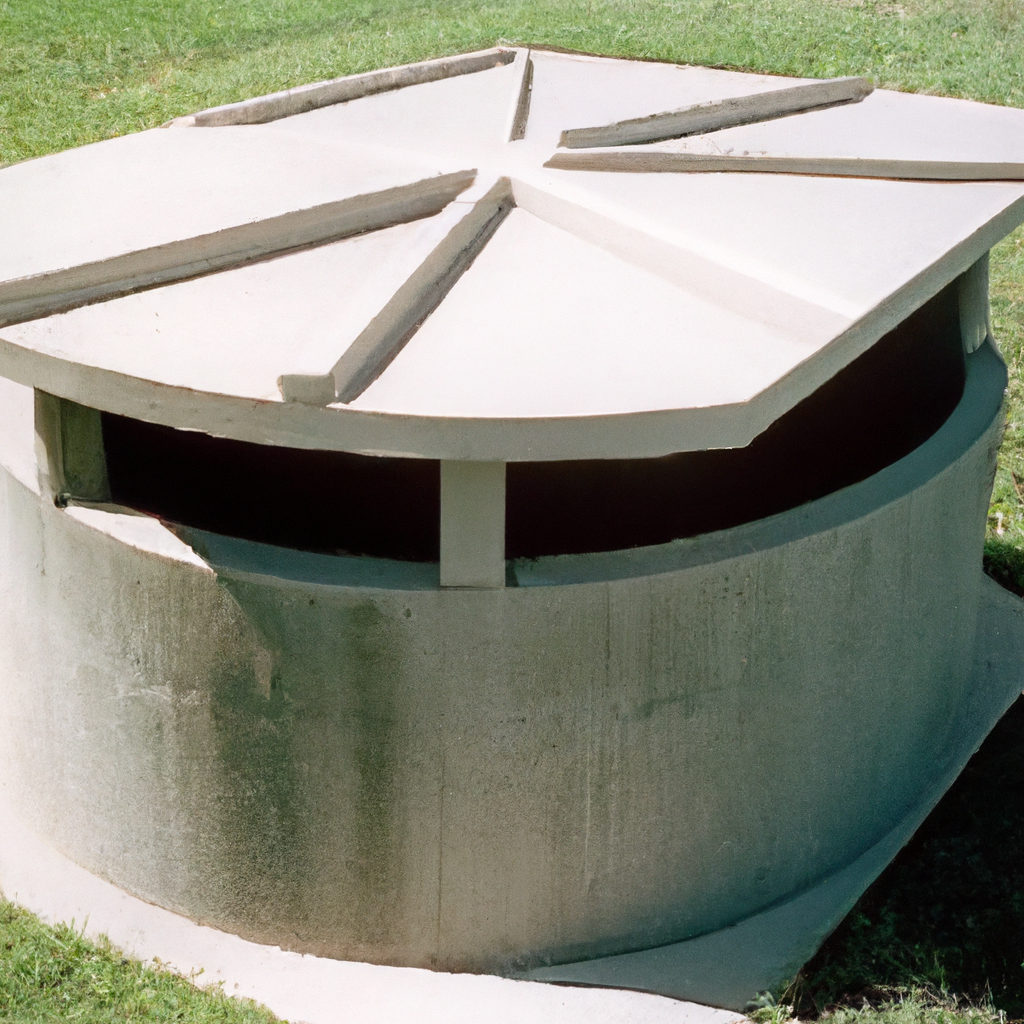If you’re a homeowner with a septic tank, you understand the importance of regular maintenance and inspection to keep your system running smoothly. However, have you ever considered the benefits of adding a concrete septic tank lid riser to your system? This simple yet effective addition can make a world of difference when it comes to accessing and maintaining your septic tank. In this article, we will explore why a concrete septic tank lid riser is worth considering, from its convenience and durability to its cost-effectiveness. Whether you’re a seasoned homeowner or a first-time septic tank owner, read on to discover how this small but impactful upgrade can streamline your septic system maintenance.
Understanding Septic Tank Riser
What is a septic tank riser
A septic tank riser is an extension or an elevated structure that is installed on top of a septic tank. It serves as an access point to the septic tank, allowing for easier maintenance, inspection, and pumping of the tank. It is typically made of materials such as concrete, plastic, steel, or fiberglass, depending on the specific requirements and preferences of the homeowner.
Functions of a septic tank riser
The primary function of a septic tank riser is to provide convenient access to the septic tank. Without a riser, homeowners would need to dig up the soil or remove the heavy concrete lid every time the tank needs to be pumped or inspected. The riser eliminates the need for such labor-intensive tasks, making maintenance and servicing more efficient and less time-consuming.
Types of septic tank risers
There are several types of septic tank risers available on the market, with each type offering its own unique set of features and benefits. The most common types include concrete septic tank risers, plastic septic tank risers, steel septic tank risers, and fiberglass septic tank risers. It is important to consider factors such as durability, resistance to environmental factors, ease of maintenance, and cost when choosing the right type of septic tank riser for your specific needs.
Introduction to Concrete Septic Tank Lid Riser
Definition of Concrete septic tank lid riser
A concrete septic tank lid riser is a type of septic tank riser that is specifically constructed using concrete material. It is designed to withstand the weight and pressure of the soil above the septic tank, while providing a durable and long-lasting solution for accessing the tank. Concrete septic tank lid risers are often preferred for their strength, longevity, and resistance to environmental factors.
Composition and structure
A concrete septic tank lid riser is typically made up of a mixture of cement, sand, gravel, and water. These materials are combined to form a solid structure that is capable of supporting the weight of the soil and other external forces. The riser is usually cylindrical in shape and is installed on top of the septic tank, with a secure connection to the tank’s opening.
Working mechanism of a concrete septic tank lid riser
The working mechanism of a concrete septic tank lid riser is relatively simple. Once installed on top of the septic tank, it provides a raised platform that allows for easy access to the tank’s interior. The riser is equipped with a secure lid or cover, which can be easily opened or removed when maintenance or inspection is required. This access point eliminates the need for digging and provides a safe and efficient means of accessing the septic tank.

Advantages of Concrete Septic Tank Lid Riser
Durability and strength
One of the key advantages of a concrete septic tank lid riser is its durability and strength. Concrete is a robust and long-lasting material that can withstand heavy loads and external pressures. It ensures that the riser can withstand the weight of the soil and other objects placed on top of it without experiencing any structural failures or damage. This durability guarantees the long-term functionality and reliability of the septic tank lid riser.
Resistance to environmental factors
Concrete septic tank lid risers are also highly resistant to various environmental factors, including temperature changes, moisture, and chemical exposure. Unlike plastic or steel risers, concrete does not deteriorate or warp under extreme conditions, ensuring that the riser remains intact and functional for extended periods. This resistance to environmental factors is crucial in maintaining the overall integrity and performance of the septic system.
Ease of maintenance
Another significant advantage of concrete septic tank lid risers is their ease of maintenance. Concrete is a low-maintenance material that requires minimal upkeep. The riser can be easily cleaned using standard cleaning agents and equipment, ensuring that it remains free from debris and contaminants. Additionally, concrete risers do not require frequent repairs or replacements, further reducing the maintenance burden on homeowners.
Comparing Concrete Septic Tank Lid Riser with Other Types
Comparison with plastic septic tank lid riser
When comparing concrete septic tank lid risers with plastic alternatives, several factors come into play. While plastic risers may be more affordable initially, they are prone to warping or cracking over time due to temperature changes and exposure to sunlight. On the other hand, concrete risers offer superior durability and resistance to environmental factors, making them a more reliable and long-lasting choice in the long run.
Comparison with steel septic tank lid riser
Steel septic tank lid risers, although strong and durable, may corrode over time due to moisture and chemical exposure. Concrete risers, on the other hand, are not susceptible to corrosion, ensuring their longevity and reliability. Concrete risers also tend to have a higher weight-bearing capacity, making them an ideal choice for areas with heavy soil or high traffic.
Comparison with fiberglass septic tank lid riser
Fiberglass septic tank lid risers may offer lightweight characteristics, but they are not as durable and robust as their concrete counterparts. Concrete risers are better equipped to handle the weight of the soil and withstand external pressures, making them a more viable option for long-term use. Additionally, concrete risers are less likely to warp or crack over time.

Potential Downsides of Concrete Septic Tank Lid Risers
Issues with weight
One potential downside of concrete septic tank lid risers is their weight. Concrete is a heavy material, making the installation and removal of the riser a more labor-intensive task. It may require additional manpower or specialized equipment to handle the weight of the riser, adding to the overall cost and complexity of the installation process.
Challenges with installation
Concrete septic tank lid risers may also pose challenges during the installation process. Due to their weight and size, proper alignment and placement of the riser can be difficult. It is crucial to ensure that the riser is properly secured to the septic tank and that it creates a watertight seal to prevent any leaks or seepage. Improper installation can lead to structural issues or compromise the functionality of the septic system.
Possible need for regular inspections and repairs
While concrete risers are generally low-maintenance, regular inspections and occasional repairs may be necessary. Over time, the riser may develop cracks or chips, especially if exposed to extreme temperature changes or physical impacts. These issues can be easily addressed through timely repairs, ensuring the continued functionality and performance of the riser.
Cost Implications of Concrete Septic Tank Lid Riser
Initial cost and installation fees
Concrete septic tank lid risers generally have a higher initial cost compared to plastic or fiberglass alternatives. The cost includes the materials, labor, and equipment required for installation. However, considering the durability and longevity of concrete risers, the initial investment proves to be cost-effective in the long term.
Maintenance and repair costs
Maintenance and repair costs for concrete septic tank lid risers are typically minimal. As mentioned earlier, concrete is a low-maintenance material that requires minimal cleaning and upkeep. Repairs, if needed, usually involve simple patching or sealing techniques, which can be done at a relatively low cost by professionals.
Cost-effectiveness and value over time
Despite the higher initial cost, concrete septic tank lid risers offer excellent value over time. Their durability and resistance to environmental factors ensure a longer lifespan compared to other materials. This means that homeowners can avoid frequent replacements or repairs, saving money in the long run. Additionally, the reliable performance of a concrete riser reduces the risk of potential septic system failures, which can be costly and time-consuming to fix.

Installing a Concrete Septic Tank Lid Riser
Preparation for installation
Before installing a concrete septic tank lid riser, proper preparation is essential. The area surrounding the septic tank should be cleared of any debris, vegetation, or soil. It is important to ensure a solid and leveled foundation for the riser to avoid any uneven settling or shifting over time. Adequate safety measures should also be in place to prevent accidents or injuries during the installation process.
Steps for installing a concrete septic tank lid riser
- Measure the diameter and depth of the septic tank opening to determine the size of the riser needed.
- Purchase a precast concrete riser that matches the measurements obtained.
- Clean the septic tank opening and remove any obstructions or debris.
- Apply a layer of sealing agent or adhesive to the top of the septic tank opening.
- Carefully place the concrete riser on top of the septic tank, ensuring a secure and watertight connection with the sealing agent.
- Verify that the riser is properly aligned and leveled.
- Secure the riser to the septic tank using bolts or other appropriate fastening methods.
- Test the stability and integrity of the riser before proceeding with further installations or adjustments.
Safety measures during installation
During the installation of a concrete septic tank lid riser, it is important to prioritize safety. This includes wearing appropriate protective gear, such as gloves and safety glasses, to reduce the risk of injuries. It is also crucial to follow proper lifting techniques when handling the heavy concrete riser to prevent strains or accidents. If necessary, seek assistance from professionals or experienced individuals to ensure a safe and successful installation process.
Maintenance of a Concrete Septic Tank Lid Riser
Routine checks and inspections
Regular checks and inspections are essential for maintaining the functionality and longevity of a concrete septic tank lid riser. This includes visually inspecting the riser for any signs of cracks, chips, or damage. Additionally, ensure that the riser’s lid or cover is secure and watertight to prevent any entry of foreign objects, water, or pests.
Cleaning and servicing
Cleaning the concrete septic tank lid riser is a simple task that can be accomplished using standard cleaning agents and equipment. It is important to remove any debris, leaves, or dirt that may accumulate on the riser. Servicing may involve removing the lid or cover to inspect the condition of the septic tank and perform necessary maintenance tasks, such as pumping or emptying the tank.
Repair and replacement procedures
In the event of cracks, chips, or other damage to the concrete septic tank lid riser, timely repairs should be carried out. This may involve patching the damaged areas using appropriate concrete repair products or seeking professional assistance for more extensive repairs. If the damage is beyond repair, it may be necessary to replace the entire riser to ensure continued functionality and safety.

Regulations Surrounding Concrete Septic Tank Lid Risers
Legal requirements and permits
The installation of a concrete septic tank lid riser is subject to local regulations and guidelines. Before proceeding with the installation, homeowners should consult with their local health department or relevant authorities to obtain the necessary permits and approvals. Compliance with these legal requirements ensures that the installation is done in accordance with the established standards and regulations.
Compliance guidelines and standards
Concrete septic tank lid risers must comply with specific guidelines and standards to ensure their safety and functionality. These guidelines may include specifications regarding the material strength, dimensions, and installation techniques. It is important to follow these guidelines to ensure that the riser meets the required standards and performs as intended.
Common violations and penalties
Failure to comply with the regulations surrounding concrete septic tank lid risers can result in various penalties and violations. These may include fines, legal actions, or even the removal of non-compliant risers. It is crucial for homeowners to understand and adhere to the regulations to avoid any unnecessary consequences and to ensure the overall safety and compliance of their septic system.
Conclusion: Determining If a Concrete Septic Tank Lid Riser is Right for You
Considerations when choosing a septic tank lid riser
When considering a septic tank lid riser, several factors should be taken into account. These include the composition, durability, resistance to environmental factors, and cost implications. Evaluating these factors alongside individual needs and preferences will help determine the most suitable type of septic tank lid riser for one’s specific situation.
Review of advantages and potential downsides
In reviewing the advantages of a concrete septic tank lid riser, its durability, resistance to environmental factors, and ease of maintenance stand out as significant benefits. However, the potential downsides, such as the weight and installation challenges, must also be considered before making a decision.
Personalized recommendations based on individual needs and constraints
Ultimately, the decision of whether a concrete septic tank lid riser is right for an individual’s situation depends on their specific needs and constraints. Factors such as budget, location, soil conditions, and personal preferences should be considered when making the final choice. Seeking professional advice and consulting with experts in the field can provide valuable insights to help make an informed decision.
Overall, a concrete septic tank lid riser offers numerous advantages in terms of durability, resistance to environmental factors, and ease of maintenance. While there may be potential downsides and cost implications, weighing these factors against individual needs and constraints is crucial in determining whether a concrete septic tank lid riser is the right choice for you.

